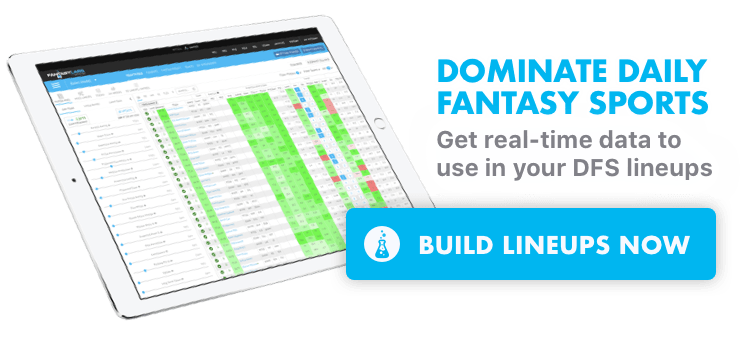The NBA regular season is winding down, which means we should start thinking about DFS strategy for the postseason. While the classic slates will still be available — at least early in the postseason — many of the larger contests will feature the popular one-game formats on both DraftKings and FanDuel.
I’m going to take a look at a few strategies for both sites, starting today with DraftKings’ Showdown format.
I’ve crunched the numbers from the past 10 days — which is as far back as DraftKings keeps slates in their archives — and have found a few interesting trends from the 19 total slates. Nineteen total slates is not a huge sample size, but it’s still healthy enough to draw a few conclusions.
This piece has also been updated with data from the Eastern and Western Conference Finals in anticipation of the massive guaranteed prize pools scheduled for the NBA Finals. Game 1 features a $2.5 million tournament on DraftKings, with first place taking home $1 million.
Let’s start with one of the biggest takeaways.
Editor’s Note: Looking for a new way to play DFS? Check out our Sleeper promo code for single-game fantasy pick’em games.
Pay up at Captain
The winning lineup in 17 of the 19 slates I looked at paid at least $11,400 at the captain position. Only one winning lineup paid less than $8,100, and the average salary for the winning captain was just under $14,800.
This makes sense when you think about it. Stars-and-scrubs was the most effective strategy when I broke down winning GPP lineups in the classic format, and this is the Showdown equivalent. You don’t necessarily need to spend up for the most expensive player at captain, but you want someone who can take advantage of the 1.5x multiplier and deliver a bunch of raw points.
This rang especially true during the Conference Finals. Only one winning Captain cost less than $11,100 (Brook Lopez at $6,300 during Game 1 of the ECF), and the average winning Captain cost $14,955. Steph Curry, Draymond Green, Giannis Antetokounmpo, or Kawhi Leonard was the winning Captain in eight of the 10 showdown slates. You basically need a big name up top.
Spend the Cap
This goes right along with paying up at captain, because it’s going to be very hard to stay under the $50,000 salary cap if you’re paying close to $15,000 for one player.
That said, don’t stop by just paying up at captain. Pairing an expensive captain with a few additional superstars appears to be the preferred strategy among winners. Winning lineups averaged over $11,100 for their first utility player and over $9,500 for their second.

Credit: Jeff Hanisch-USA TODAY Sports. Pictured: Philadelphia 76ers guard Ben Simmons (25), Milwaukee Bucks forward Giannis Antetokounmpo (34).
When combined with your captain, that means that three players are accounting for more than $35,600 on average, which is equivalent to roughly 71.2% of the cap space. High-salaried players give you the safest floor and highest ceiling on a night-to-night basis, so it makes sense to jam as many of them into a given lineup as possible.
Winning Showdown lineups posted an average salary of greater than $49,400, and all but one winner spent at least $48,700. Salary dollars are a precious resource in NBA DFS regardless of the format.
The average winning salary was almost identical during the Conference Finals, checking in at $49,420, and winning lineups were chalk-full of superstars. Antetokounmpo and Leonard appeared in every winning lineup during the Eastern Conference Finals. Ditto for Curry and Green during the Western Conference Finals. Those lineups also frequently featured other “borderline studs” in guys like Damian Lillard, C.J. McCollum, Kyle Lowry, and Pascal Siakam. The stars and scrubs approach definitely appears to be the preferred strategy during the postseason.
Look for “Black Swans”
So far, I’ve detailed paying up captain and jamming multiple studs into your lineups. Those guys are all going to command massive ownership in the showdown format — we’re talking up to 90% on occasion — so you’re going to need to diversify your lineups by looking for some “black swans.”
Nassim Nicholas Taleb coined the term “black swan” for investing, and our own Jonathan Bales and Matt Freedman have done a great job of applying the term to daily fantasy sports. Essentially, a “black swan” for DFS purposes is a player who is very rarely going to be a positive producer, but when he does he has the ability to be a GPP-winner.
These players are relevant in traditional DFS, but they’re possibly even more relevant in the one-game formats.
When you’re forced to build a roster from just two available teams, it doesn’t leave a ton of ways to be contrarian. The superstars will be owned at a tremendous rate, the rest of the starters will be right behind them and the relevant bench players will be covered as well. If you want to get contrarian in this format, you’re going to need to tread in waters that you would never consider in traditional DFS.

Credit: Erik Williams-USA TODAY Sports. Pictured: Houston Rockets guard Austin Rivers (25), Philadelphia 76ers guard T.J. McConnell (12).
That may make you uncomfortable, but that’s what makes these guys black swans! Most people would never dream of ‘ruining’ their lineup with a player who has the potential for single-digit scoring, which is why you can grab them at minimal ownership.
This is reflected in the data. The cheapest player on winning rosters averaged out to approximately $2,500, and 52.6% of winners used a player who was $2,000 or cheaper. These players averaged an ownership of just 18.4%, which allowed them to compile a contrarian roster without sacrificing the top-end stud production.
Once again, this strategy held true during the Conference Finals. The cheapest player on winning rosters averaged out to $2,780, while the second-cheapest player cost $4,200. It’s clear that you need the superstar production, and the only way to jam three or four of them into your lineup is by shopping in the clearance section for your final roster spots. Guys like George Hill, Fred VanVleet, and Norman Powell filled this role in the East, while Alfonzo McKinnie, Jordan Bell, and Shaun Livingston were each featured in at least one winning lineup out West.
Are you going to lose money chasing “black swans”? Absolutely. But picking the correct “black swan” is a good way to find yourself at the top of the leaderboard instead of in the middle.
Don’t Over-Stack
Stacking is something that doesn’t get a ton of attention in NBA DFS. Yes, you can stack a particular game if you think it’s going to shoot out or go to overtime, but we don’t think about stacking the same way we do in other sports. In football, a receiver can’t catch a pass unless someone throws it to him. In baseball, you can’t get an RBI unless someone scores a run. Stacking in those sports makes a ton of sense because the scoring is all highly correlated.
The only kind of correlated scoring in the NBA is with assists, and that isn’t even guaranteed to occur on every possession. Having the ball in your hands is a good thing for NBA DFS — that’s why usage rate is so important — and only one player on each team can have the ball at a time. As a result, there’s only so much fantasy scoring to go around in an NBA game.
Think of a team’s fantasy output as a pie. The bigger the piece that one player grabs, the less it leaves for the rest of his teammates.

Credit: Alonzo Adams-USA TODAY Sports. Pictured: Oklahoma City Thunder center Steven Adams (12), guard Russell Westbrook (0), guard Dennis Schroder (17).
With that in mind, it’s not surprising that most of the winning lineups in the Showdown format featured either three players from both teams or four from one and two from the other. Only one winning lineup from the 19 slates I tracked had five players from the same team.
Loading up on five players from one team doesn’t appear to give you the same upside as the other combinations. Stacking five players means you’re essentially looking to gobble up one pie while leaving the other untouched, but winning combinations grabbed as much as possible from each.
Correlate Your Lineups
Even if you try to stay balanced on the Showdown slates, you’re still going to wind up with at least three players from the same team. That means it makes sense to look for players who can complement each other’s abilities.
Luckily, we have a correlations tab within our NBA Models to help accomplish this task.
Let’s take the Thunder for example. Russell Westbrook has positive correlations with only Nerlens Noel and Paul George on the current roster. His worst correlation is with Dennis Schroder, which means that pairing those two players together is likely a losing strategy. If one of the two goes off, odds are that it will be at the direct expense of the other.
On the Rockets, James Harden has positive correlations with virtually all of his teammates, with the lone exception being Chris Paul. If you’re playing a showdown slate, you probably want to choose between the two instead of jamming both in.
Most players are probably not thinking about correlations when creating lineups, so using this information should give you a leg up on your competition.
Pictured above: Toronto Raptors guard Kyle Lowry (7)
Credit: Bill Streicher-USA TODAY Sports







